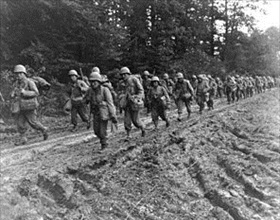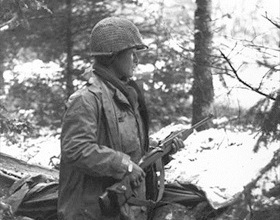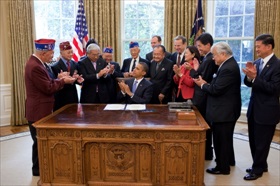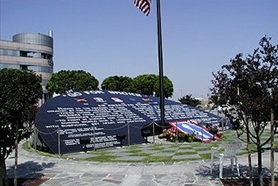GERMANS FEAR TRAP, ABANDON NORMANDY
Marseille, France · August 16, 1944
On this date in 1944, two-and-one-half months after the Allies had landed in northern France (Operation Overlord) and one day after thousands of servicemen from the U.S. Seventh and French First armies had landed by air and sea on the French Riviera (Operation Dragoon), Adolf Hitler reversed himself and ordered his troops out of Normandy to a new defense line in northeastern France on the Somme and Marne rivers. The Franco-American landings in southern France opened a second front, providing the Allies with additional and sorely needed port facilities at Marseille and Toulon. Over the next two months the Allied advance northward from the Mediterranean coast through the Rhône Valley pushed the Germans toward their own border. The advance came to a halt at the foothills of the Vosges Mountains due to lack of fuel. There the U.S. Seventh Army linked up with Gen. George Patton’s Third Army moving east from Normandy, to become part of Gen. Dwight D. Eisenhower’s European Theater command. In their Vosges Mountain fortress, the toughest terrain on the Western Front, retreating Wehrmacht soldiers were ordered by Hitler to stand and fight. The Vosges Mountains campaign is notable for the rescue of “The Lost Battalion,” the 1st Battalion, 141st Infantry, which was surrounded by German forces on October 24, 1944. In five days of battle, from October 26 to October 30, the 442nd Regimental Combat Team, a unit composed of mostly second-generation Japanese Americans (Nisei), broke through German defenses and rescued about 230 men while suffering over 800 casualties. (The 442nd is considered to be the most-decorated infantry regiment in the history of the U.S. Army. Its record-setting decoration count earned it the nickname “Purple Heart Battalion.”) The Allied victory in the monthlong Vosges slugfest freed Patton to focus on driving east to the Rhine River and striking into the German heartland. Hitler, however, had one last ace up his sleeve, which he played in the Ardennes forest of Belgium and Luxembourg, site of the Battle of the Bulge in December 1944. It was Germany’s last-ditch effort to stop the Allied advance into Germany proper, and it failed.
[amazon_carousel widget_type=”ASINList” width=”600″ height=”200″ title=”Recommended Reading” market_place=”US” shuffle_products=”False” show_border=”False” asin=”0806143371,0891417273,0891416226,0891416307,0979689619,0295987456,0345476115,1592401988,0312354649,1467547891″ /]
Japanese American Contributions to Winning the War in Europe
 |  |
Left: The 442nd Regimental Combat Team hike up a muddy French road, late 1944. The newly formed Nisei 442nd Combat Team left the U.S. on May 1, 1944, and landed at Anzio, Italy, on May 28. In August the unit took part in Operation Dragoon, the invasion of southern France, and traveled 500 miles up the Rhône Valley, by walking and by rail, until October 13, when it reached the Vosges Mountains. On October 23 the unit, whose motto was “Go for Broke,” was ordered to rescue the “lost battalion” of 141st “Alamo Regiment” of the 36th (Texas) Division. It cost the 442nd 800 casualties to rescue 230 men.
![]()
Right: A 442nd squad leader looks for German movements in a French valley 200 yards away, November 1944. The 442nd was the most decorated unit for its size and length of service in the history of American warfare. Its members—in total, about 14,000 men—received 18,143 awards, including 9,486 Purple Hearts. The unit was awarded an unprecedented eight Presidential Unit Citations. Twenty-one of its members were awarded Medals of Honor, including future senator Daniel Inouye of Hawaii. The men of the 442nd Regimental Combat Team accounted for just over 40 percent of the Japanese Americans who served in the U.S. military in World War II.
 |  |
Left: When President Harry S. Truman welcomed the return home of the 442nd Regimental Combat Team (raised on the mainland) and its component 100th Infantry Battalion (raised in Hawaii), he said: “You not only fought the enemy, but you fought prejudice and you’ve won.” On October 5, 2010, President Barack Obama signed a bill granting the Congressional Gold Medal collectively to the 442nd Regimental Combat Team and the 100th Infantry Battalion in recognition of their dedicated service during World War II. The award was also extended to the 6,000 Japanese Americans who served in the Military Intelligence Service during the war.
![]()
Right: The Go For Broke Monument in Little Tokyo, Los Angeles, California commemorates the 33,000 Japanese Americans who served in the U.S. military during World War II—the famed 100th Infantry Battalion and 442nd Regimental Combat Team, as well as lesser-known Nisei units, the Military Intelligence Service, the 522nd Field Artillery Battalion, the 232nd Combat Engineer Company, and the 1399th Engineering Construction Battalion. “Go For Broke!” was the unit motto of the 100th Battalion and was adopted by the 442nd RCT. It has since been adopted as a motto for all of the Japanese American units formed during World War II.
Well-Done Amateur Account of 442nd Regiment and the Rescue of “The Lost Battalion”
![]()

 History buffs, there is good news! The Daily Chronicles of World War II is now available as an ebook for $4.99 on Amazon.com. Containing a year’s worth of dated entries from this website, the ebook brings the story of this tumultuous era to life in a compelling, authoritative, and succinct manner. Featuring inventive navigation aids, the ebook enables readers to instantly move forward or backward by month and date to different dated entries. Simple and elegant! Click
History buffs, there is good news! The Daily Chronicles of World War II is now available as an ebook for $4.99 on Amazon.com. Containing a year’s worth of dated entries from this website, the ebook brings the story of this tumultuous era to life in a compelling, authoritative, and succinct manner. Featuring inventive navigation aids, the ebook enables readers to instantly move forward or backward by month and date to different dated entries. Simple and elegant! Click 











